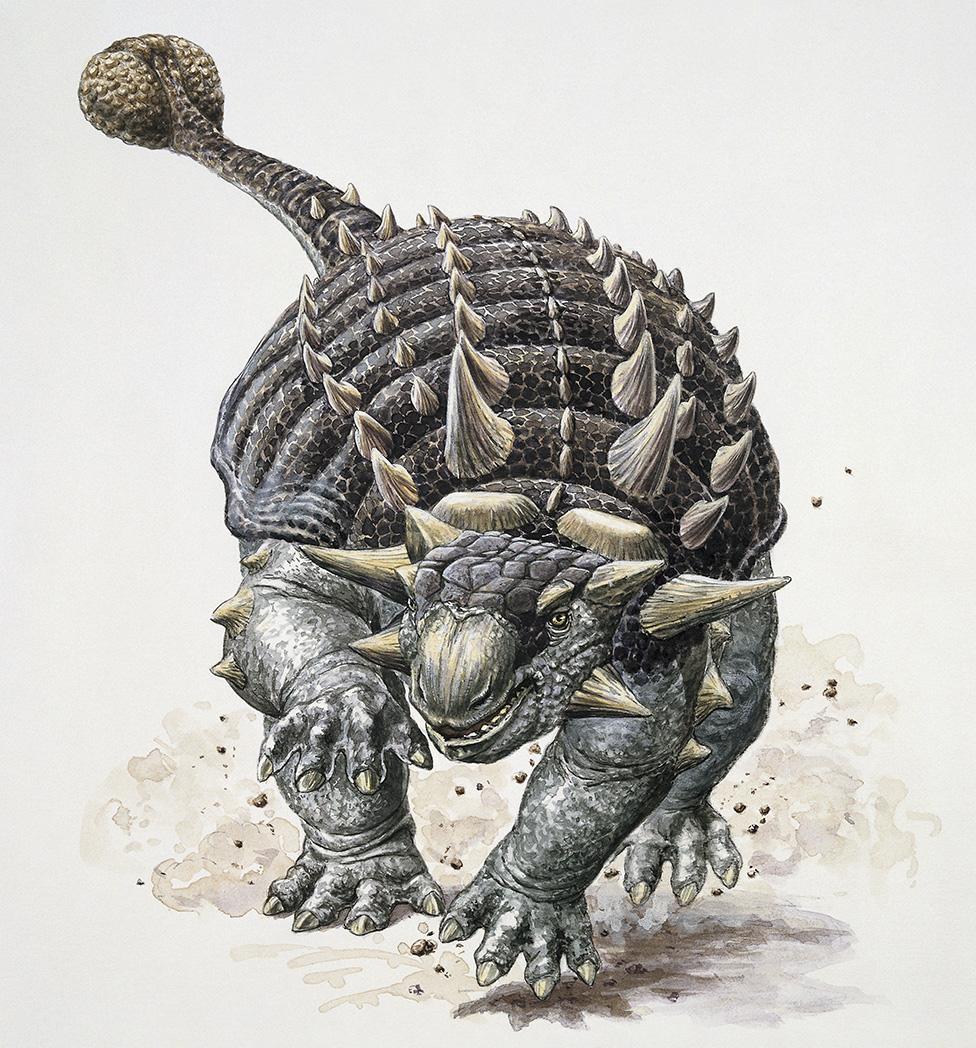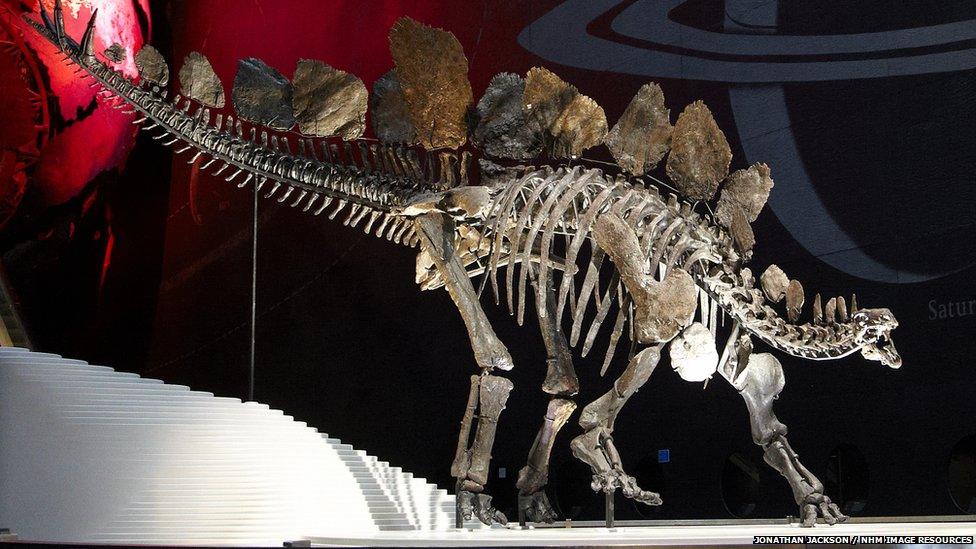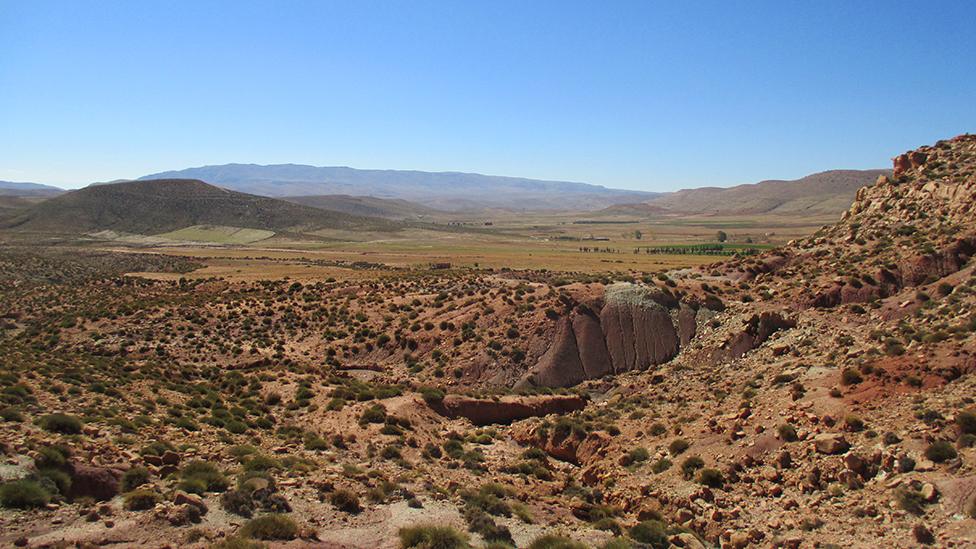Dinosaurs: 'Bizarre' fossil is Africa's first ankylosaur
- Published
Dr Susie Maidment: "It's bizarre; it's honestly bizarre"
"Think of a coffee table. Short, broad, covered in spikes and walking towards you. That's an ankylosaur!"
Dr Susie Maidment is describing a fabulous new fossil in her possession.
All she has is a section of rib with prongs attached. But even from just this, the palaeontologist can tell it's a novel species of armoured dinosaur and the oldest ankylosaur ever found.
What's more, it's come out of Africa, from Morocco, where these creatures have never been unearthed before.
That's exciting enough but there's also something very strange about this ancient specimen.
The spikes are fused directly to the bone, and this is a big puzzle, says Dr Maidment, who's affiliated to London's Natural History Museum (NHM).

Think armoured coffee table: Some ankylosaurs had a club-like feature on their tail
Ordinarily, you would expect rib bones to be covered by muscle, and then by skin, and for the armour - made of a protein called keratin, like your fingernails - to be sitting on top of that.
But for the spikes to be connected straight through to the bone is just odd. For one thing, you'd think this would restrict the extension of the muscles and make it difficult for the animal to move.
"Honestly, it's bizarre," Dr Maidment told BBC News.
"We don't see this in any other extant (still living) or extinct vertebrate anywhere. It's a totally unprecedented morphology in the history of life on Earth."
Dr Maidment's team were so taken aback by the fossil, they wondered for a while whether it might actually be a fake, or not an ankylosaur at all; perhaps it was some monster fish never previously identified. But with detailed scanning and further investigations, it's been possible to rule out both alternatives.
Museum scientists scanned the fossil as part of their investigation
Most of us are probably more familiar with stegosaurs. They were the armoured dinosaurs that had a row of imposing plates down their spine. You'll see a magnificent specimen, nicknamed Sophie, if you visit the NHM.
Ankylosaurs were their evolutionary cousins. And very successful they were, too.
They lived right through the Cretaceous, right up to the moment the asteroid struck 66 million years ago to wipe out 75% of all plant and animal species on the planet.
When precisely the ankylosaurs first emerged, however, is still being studied, which makes this newly reported specimen extra special.
It dates to the Middle Jurassic Period, around 168 million years ago.

At the NHM, you can see the most complete stegosaur skeleton in the world
This helps fill in important gaps in our knowledge of dinosaur history, and suggests strongly that ankylosaurs had a global distribution.
"Ankylosaurs are extremely well known from the northern continents, from North America and Asia particularly. But they're extremely poorly known from the southern continents," explained Dr Maidment.
"There's been tantalising remains that suggest they were there, but we haven't had much firm evidence, apart from one good specimen from Australia.
"This is the first ankylosaur from Africa, and it's also from a really, really, early time period. We had long-suspected that ankylosaurs must be around in the Middle Jurassic because we have stegosaurs from the Middle Jurassic.
"Stegosaurs and ankylosaurs are closely related to each other, so it makes sense that if the stegosaurs had evolved by then, the ankylosaurs must have done as well."

Morocco: Many more dinosaur discoveries will be made in Africa
Dr Maidment has named the new dinosaur Spicomellus afer.
Spicomellus meaning "collar of spikes" and afer meaning "of Africa".
The specimen was discovered by a farmer in the Middle Atlas Mountains of Morocco, the same location where NHM researchers had previously identified the oldest stegosaur ever found.
Dr Maidment had briefly visited the site before Covid restrictions made follow-up excavations impossible.
When things get back to normal, she'll be back out to Morocco to see if there are any other pieces of the ankylosaur that can help shed light on its unusual physiology.
The description of the new specimen is published in the journal Nature Ecology & Evolution, external.
